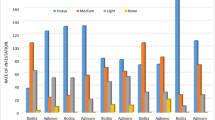Abstract
Objectives: To determine the relationship between consumption of E. coli contaminated well-water and gastrointestinal illness in rural families.
Methods: One hundred and eighty-one families with well-water as a drinking source participated in a one-year follow-up study. Water was tested for E. coli bacteria and health outcomes were monitored for household members.
Results: E. coli in well-water was significantly associated with gastrointestinal illness in family members, however the relationship was modified by the distance from the septic tank to the well. E. coli had an odds ratio of 2.16 [95% CI 1.04, 4.42] if the septic tank was greater than 20 metres from the well and 0.46 [95% CI 0.07, 2.95] if the septic tank was within 20 metres.
Conclusions: Consumption of contaminated well-water is associated with gastrointestinal illness. E. coli can be a useful marker for detecting wells that pose a potential public health problem in rural areas.
Résumé
Objectifs: Étudier l’association possible entre la consommation d’eau de puits contaminée par E. coli et l’occurrence de maladies gastro-intestinales dans les familles rurales.
Méthodes: Cent quatre-vingt et une familles ayant un puits comme source d’eau de consommation ont participé à une étude s’échelonnant sur une année. L’eau de puits a été analysée pour la recherche E. coli et l’état de santé de chaque membre de la famille a été suivi.
Résultats: La présence de E. coli dans l’eau de puits était signifïcativement associée aux maladies gastro-intestinales chez les membres de la famille quoique cette relation était dépendante de la distance entre le puits et la fosse septique. Le rapport de cotes du E. coli était de 2,16 [95% IC 1,04, 4,42] si la fosse septique était à plus de 20 mètres et 0,46 [95% IC 0,07, 2,95] si la fosse septique était à moins de 20 mètres du puits.
Conclusions: La consommation d’eau de puits souillée est associée aux maladies gastro-intestinales. Le E. coli peut être un indicateur utile pour détecter les puits qui posent un problème potentiel de santé publique dans les zones rurales.
Similar content being viewed by others
References
Rudolph D, Goss M. Ontario farm groundwater quality survey. Guelph, Ontario: A report prepared for Agriculture Canada, Agri-Food Development Branch, 1992.
Ministry of the Environment. Ontario’s Drinking Water Objectives: Environment Information. Ottawa: Ministry of the Environment, 1992.
Fattal B, Guttman-Bass N, Agursky T, Shuval HI. Evaluation of health risk associated with drinking water quality in agricultural communities. Wat Sci Tech 1988;20:409–15.
Zmirou D, Ferley JP, Collin JF, et al. A follow-up study of gastro-intestinal diseases related to bacteriologically substandard drinking water. Am J Public Health 1987;77:582–84.
Morris RD, Naumova EN, Levin R, Munasinghe RL. Temporal variation in drinking water turbidity and diagnosed gastroenteritis in Milwaukee. Am J Public Health 1996;86:237–39.
Payment P, Richardson L, Siemiatycki J, et al. A randomized trial to evaluate the risk of gastrointestinal disease due to consumption of drinking water meeting current microbiological standards. Am J Public Health 1991;81:703–8.
Moore AC, Herwaldt BL, Craun GF, et al. Surveillance for Waterborne Disease Outbreaks-United States, 1991–1992. Morb Mortal Wkly Rep 1993;42(SS-5):1–22.
Todd E. Foodborne and Waterborne Disease in Canada, Annual Summaries 1992 and 1993. Ottawa: Health Protection Branch, Health and Welfare Canada, 1998.
Rothman K. Modern Epidemiology. Boston: Little, Brown and Co., 1986; 172
Diggle PJ, Liang K-Y, Zegger SL. Analysis of Longitudinal Data. Oxford: Caledron Press, 1994.
Hosmer D, Lemeshow S. Applied Logistic Regression. New York: John Wiley and Sons, 1989;68–71.
Monto AS, Koopman JS. The Tecumseh Study XI: Occurrence of acute enteric illness in the community. Am J Epidemiol 1980;112:323–33.
Author information
Authors and Affiliations
Rights and permissions
About this article
Cite this article
Raina, P.S., Pollari, F.L., Teare, G.F. et al. The Relationship Between E. coli Indicator Bacteria in Well-water and Gastrointestinal Illnesses in Rural Families. Can J Public Health 90, 172–175 (1999). https://doi.org/10.1007/BF03404501
Received:
Accepted:
Published:
Issue Date:
DOI: https://doi.org/10.1007/BF03404501




